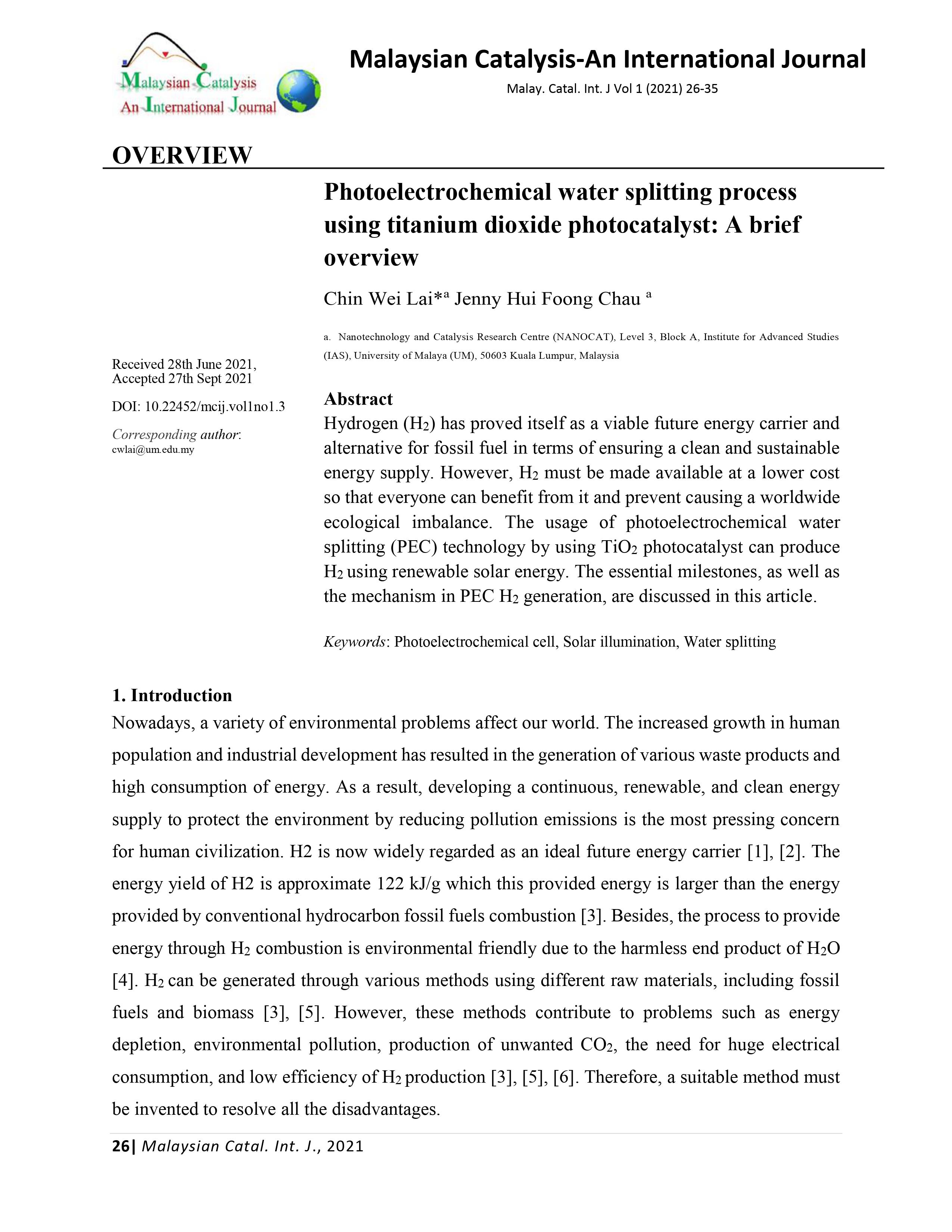Photoelectrochemical water splitting process using titanium dioxide photocatalyst: A brief overview
Abstract
Hydrogen (H2) has proved itself as a viable future energy carrier and alternative for fossil fuel in terms of ensuring a clean and sustainable energy supply. However, H2 must be made available at a lower cost so that everyone can benefit from it and prevent causing a worldwide ecological imbalance. The usage of photoelectrochemical water splitting (PEC) technology by using TiO2 photocatalyst can produce H2 using renewable solar energy. The essential milestones, as well as the mechanism in PEC H2 generation, are discussed in this article.
Downloads
References
Y. Zhang, Y. Bu, L. Wang, and J.-P. Ao, Regulation of the photogenerated carrier transfer process during photoelectrochemical water splitting: A review, Green Energy Environ. 2020, pp. 479-495
R. Singh and S. Dutta, A review on H2 production through photocatalytic reactions using TiO2/ TiO2-assisted catalysts, Fuel, 2018, 220, pp. 607–620.
S. E. Hosseini and M. A. Wahid, Hydrogen production from renewable and sustainable energy resources: Promising green energy carrier for clean development, Renew. Sustain. Energy Rev., 2016, 57, pp. 850–866.
C. Acar and I. Dincer, Review and evaluation of hydrogen production options for better environment, J. Clean. Prod., 2019, 218, pp. 835–849.
P. Nikolaidis and A. Poullikkas, A comparative overview of hydrogen production processes, Renew. Sustain. Energy Rev., 2017,67, pp. 597–611.
V. TD, M. TS, dos S. DDRM, and C. AD, Hydrogen: Trends, production and characterization of the main process worldwide, Int. J. Hydrogen Energy, 2017, 42(4), pp. 2018–2033.
I. Roger, M. A. Shipman, and M. D. Symes, Earth-abundant catalysts for electrochemical and photoelectrochemical water splitting, Nat. Rev. Chem., 2017, 1(1), pp. 3.
R. Li et al., Achieving overall water splitting using titanium dioxide-based photocatalysts of different phases, Energy Environ. Sci., 2015 8,(8), pp. 2377–2382.
C. R. Jiang, S. J. A. Moniz, A. Wang, T. Zhang, and J. Tang, Photoelectrochemical devices for solar water splitting – materials and challenges, Chem. Soc. Rev., 2017, 46(15), pp. 4645–4660.
N. Han et al., Perovskite and related oxide based electrodes for water splitting, J. Clean. Prod., 2021, 318, pp. 128544.
R. Michal, S. Sfaelou, and P. Lianos, Photocatalysis for renewable energy production using Photo Fuel Cells, Molecules, 2014, 19(12), pp. 19732–19750.
E. Kim, J. H. Park, and G. Han, Design of TiO2 nanotube array-based water-splitting reactor for hydrogen generation, J. Power Sources, 2008,184, pp. 284–287.
K. Yu and J. Chen, Enhancing Solar Cell Efficiencies through 1-D Nanostructures, Nanoscale Res. Lett., 2008, 4(1), pp. 1.
N. Baig, I. Kammakakam, and W. Falath, Nanomaterials: a review of synthesis methods, properties, recent progress, and challenges, Mater. Adv., 2021,.2(6), pp. 1821–1871.
F. X. Xiao and B. Liu, Plasmon-dictated photo-electrochemical water splitting for solar-to-chemical energy conversion: Current status and future perspectives, Adv. Mater. Interfaces, 2018, 5, pp. 1701098.
Y. Zhao, N. Hoivik, and K. Wang, Recent advance on engineering titanium dioxide nanotubes for photochemical and photoelectrochemical water splitting, Nano Energy, 2016, 30, pp. 728–744,
Y. Lan, Y. Lu, and Z. Ren, Mini review on photocatalysis of titanium dioxide nanoparticles and their solar applications, Nano Energy, 2013, 2(5), pp. 1031–1045.
A. Gellé and A. Moores, Water splitting catalyzed by titanium dioxide decorated with plasmonic nanoparticles, Pure Appl. Chem., 2017, 89 (12), pp. 1817-1827.
M. Jefferson, Sustainable energy development: Performance and prospects, Renew. Energy.2006, 31, pp. 571–582.
L. C. Escaliante, K. O. Rocha, and J. H. D. Silva, Stability of the photocatalytic activity of TiO2 deposited by reactive Sputtering, Mater. Res., 24(1).
J. Cabrera, H. Alarcón, A. López, R. Candal, D. Acosta, and J. Rodríguez, Synthesis, characterization and photocatalytic activity of 1D TiO2 nanostructures, Water Sci. Technol., 2014, 70, pp. 972–979.
M. Ge et al., A review of one-dimensional TiO2 nanostructured materials for environmental and energy applications, J. Mater. Chem. A, 2016, 4(18), pp. 6772–6801.
Q. Zhang et al., Anodic Oxidation Synthesis of One-Dimensional TiO2 Nanostructures for Photocatalytic and Field Emission Properties, J. Nanomater., 2014, pp. 831752.
H. Sudrajat et al., Origin of the overall water splitting activity over Rh/Cr2O3@ anatase TiO2 following UV-pretreatment, Int. J. Hydrogen Energy, 2021, pp. 31228-31238.
J. Cai, M. Zhou, X. Xu, and X. Du, Stable boron and cobalt co-doped TiO2 nanotubes anode for efficient degradation of organic pollutants, J. Hazard. Mater., 2020, 396.
X. Hou et al., Enhanced photoelectrocatalytic degradation of organic pollutants using TiO2 nanotubes implanted with nitrogen ions, J. Mater. Sci., 2020, 55(14), pp. 5843–5860.
A. Zada et al., Improved visible-light activities for degrading pollutants on TiO2/g-C3N4 nanocomposites by decorating SPR Au nanoparticles and 2,4-dichlorophenol decomposition path, J. Hazard. Mater., 2018, 342, pp. 715–723.
M. Coto et al., Tuning the properties of a black TiO2-Ag visible light photocatalyst produced by a rapid one-pot chemical reduction, Mater. Today Chem., 2017, 4, pp. 142–149.
S. A. Ansari, M. M. Khan, M. O. Ansari, and M. H. Cho, Silver nanoparticles and defect-induced visible light photocatalytic and photoelectrochemical performance of Ag@m-TiO2 nanocomposite, Sol. Energy Mater. Sol. Cells, 2015, 141, pp. 162–170.
Z. N. Kayani, A. Kamran, Z. Saddiqe, S. Riaz, and S. Naseem, Probe of ZrTiO2 thin films with TiO2-ZrO2 binary oxides deposited by dip coating technique, J. Photochem. Photobiol. B Biol., 2018, 183, pp. 357–366.
X. Shi et al., Facile construction TiO2/ZnIn2S4/Zn0.4Ca0.6In2S4 ternary hetero-structure photo-anode with enhanced photoelectrochemical water-splitting performance, Surfaces and Interfaces, 2021, 26, pp. 101323.
S. S. M. Bhat et al., Substantially enhanced photoelectrochemical performance of TiO2 nanorods/CdS nanocrystals heterojunction photoanode decorated with MoS2 nanosheets, Appl. Catal. B Environ., 2019, pp. 118102.
C. H. Liao, C. W. Huang, and J. C. S. Wu, Hydrogen production from semiconductor-based photocatalysis via water splitting, Catalysts, 2012, 2(4), pp. 490–516.





